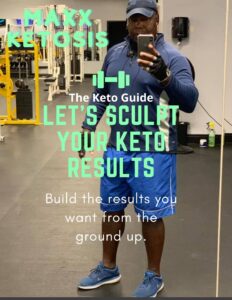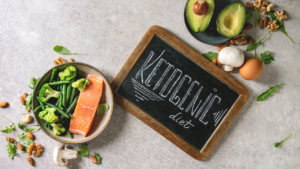
How To Get Electrolytes On Keto

Getting enough electrolytes can make or break your keto diet. With an electrolyte imbalance, your body speaks up with symptoms like headaches, fatigue, brain fog, cramping and more.
This is especially true as you transition into ketosis, but electrolytes remain an important aspect of the low-carb lifestyle throughout.
For a long time, the go-to electrolyte source for those needing a boost was sugar-filled sports drinks. What most people don’t realize, however, is that you can actually get a lot of your electrolyte needs met through diet.
And with the growing awareness around the hazards of sugar today, when you need to kick your electrolyte levels up a notch, some high-quality, sugar-free electrolyte supplements are also available to get the job done.
What Are Electrolytes?
Electrolytes are essential minerals in your body that carry an electrical charge and are responsible for a range of bodily functions[*].
Here’s what you should keep in mind about electrolytes and keto:
Sodium lives in the fluid outside of your cells (called extracellular fluid). It works in concert with potassium to create an electrical charge and move molecules in and out of cells as needed.
When sodium is low, you may experience symptoms like headache, confusion, nausea, or even delirium. When sodium is too high, you are likely to experience rapid breathing, sleeping difficulty, and restlessness[*].
Calcium is primarily found outside of cells and is involved in several processes in your body including muscle contraction and hormone function.
Signs of low calcium include tingling (often in the lips, fingers, tongue, and feet), muscle aches, spasms of muscles in the throat, stiffening of muscles, and abnormal heart rhythms[*].
Potassium primarily lives inside your cells, where it can balance the efforts of sodium. Together, they create the proper conditions for cellular functioning.
You may experience symptoms like fatigue, muscle twitching, and weakness when you’re low on potassium. If you have too much potassium, you would likely experience symptoms like heart palpitations, muscle cramps, and muscle weakness[*].
Magnesium is primarily found inside your cells and plays an important role in energy production. It’s also essential for muscle contraction and relaxation, neurological function, and the release of neurotransmitters.
When magnesium levels are low, you may experience symptoms such as nausea, vomiting, loss of appetite, weakness, lethargy, low mood, and muscle spasms[*]. Too much magnesium intake isn’t harmful but can cause diarrhea.
Why You Need Electrolytes On Keto
Everybody needs electrolytes to carry out vital functions in their body. Electrolytes are necessary for staying alive. However, you will likely need to make sure you’re consuming more than the average person on a low-carb or keto diet, especially in the beginning.
When you cut carbs, your body loses a lot of water, which also reduces your electrolyte levels temporarily. Some people notice they lose 5-10 pounds on their first week of a low-carb diet, which corresponds to a gallon of water, give or take — and along with that water, you’re also losing electrolytes you need to stay healthy.
From a scientific perspective, low-carb dieting pulls water and electrolytes out of your body in two main ways:
- Burning glucose, especially stored glucose (glycogen), which eliminated 3 milliliters of water for each gram of glycogen you oxidize (use for fuel) after going low-carb[*].
- Excreting excess ketones created early on your keto diet, which are negatively charged and can sometimes remove positively charged sodium and potassium[*].
Keto Flu and Electrolytes
Keto flu refers to the unpleasant side effects that can come with transitioning into the ketogenic diet.
Most, if not all, of these side effects, are due to low levels of electrolytes. Some of the most common symptoms of keto flu include:
- Muscle cramps
- Headache
- Constipation
- Diarrhea
- Dizziness
- Poor concentration
- Muscle soreness
- Stomach pain
- Sugar cravings
- Nausea
- Brain fog
- Fatigue
- Insomnia
Fortunately, keto flu typically only lasts about a week or so for most people, but it really throws your life off track if you don’t know how to manage it.
The good news is that the majority of keto flu symptoms can be largely curbed by making sure you replenish your electrolytes.
How To Get Electrolytes On The Keto Diet
On the keto diet, it’s not especially difficult to get electrolytes — the main issue is that early on you may flush out excess electrolytes, causing a deficiency and keto flu symptoms.
Additionally, because everyone needs electrolytes for health and survival, it’s important to eat the right foods (and take supplements if necessary) to ensure your levels are adequate.
Getting electrolytes through foods is the most economical and sustainable way to ensure you have adequate electrolytes. But if you’re already deficient, dietary electrolytes may not be fast enough for your needs.
Obtaining electrolytes with keto electrolyte supplements is the most effective and fastest way to guarantee you’ve got enough electrolytes. They’re also more convenient than relying on eating precisely the correct foods, and provide peace of mind since you know you’re getting the right amounts.
How to Get Electrolytes Through Healthy Foods on the Keto Diet
If you feel like you’re low on electrolytes, getting extra through your diet is always a smart way to go. Below are some electrolyte-rich food options to consider.
Sodium
While you may be under the impression that most people get too much sodium, for the keto dieter, sodium is your best friend — it’s a necessary electrolyte that you’re quite likely to lose as you flush out water thanks to going low-carb.
On the other hand, sodium is often added to many unhealthy, processed foods, so focusing on the quality of your sodium food sources is vital.
For instance, a typical hot dog contains over 300 mg of sodium (10-15% of an adult’s daily allowance), but the quality of the processed meat is so low that you’re better off passing on it all together[*].
The most straightforward way to get your sodium levels up at mealtime is by sprinkling some Himalayan salt, sea salt, or other table salt on your food.
However, there are plenty of keto-friendly foods that are sodium-rich as well as high-quality, including:
- Sauerkraut
- Anchovies
- Rotisserie chicken
- Canned salmon
- Canned tuna
- Salted nuts
- Organic cured meats
- Organic, nitrate-free hot dogs
- Organic, nitrate-free sausages
- Broth (chicken broth, bone broth, beef broth)
Calcium
If you’re lactose-intolerant or don’t want dairy to count toward your daily net carb intake, don’t worry. While dairy does offer a good source of calcium, there are plenty of other low-carb foods that are rich in this mineral. Some of the best calcium-rich food options include[*]:
- Sardines
- Salmon
- Turnip greens
- Kale
- Milk (preferably full fat raw milk)
- Cottage cheese
- Yogurt
Potassium
Potassium is one of the most common electrolytes in living organisms, so it can be found in a wide range of animal and plant-based foods. Some of the richest keto-friendly sources include[*]:
- Avocados
- Spinach
- Swiss chard
- Yogurt
- Milk
- Chicken breast
- Beef
- Salmon
- Turkey
- Broccoli
- Asparagus
- Cashews
Magnesium
Magnesium is found in abundance in a variety of whole foods. Some of the best healthy sources of magnesium include[*]:
- Pumpkin seeds
- Chia seeds
- Almonds
- Spinach
- Cashews
- Peanuts
Take Electrolyte Supplements
Although dietary electrolytes from food can be very helpful, they likely won’t pack the electrolyte punch your body needs during keto flu or physical activity in the heat — and that’s where electrolyte supplements come in.
Electrolyte supplements are tailor-made with the electrolytes your body needs most to fill up your stores so you don’t dip below your body’s natural threshold. In addition to transitioning into ketosis, electrolyte supplements can be useful:
- After sweating a lot
- During or after prolonged fasting periods
- If you’ve had diarrhea
- If you’ve been vomiting
- If you have noticed signs of keto flu, even though you’re not new to ketosis
Here’s what to look for in a high-quality electrolyte supplement:
- Make sure the supplement has all four major electrolytes — sodium, calcium, potassium, and magnesium.
- Avoid unnecessary added carbohydrates and sugar. Some companies will add sweeteners to their electrolytes to make them taste better, but there’s no reason for a keto dieter to waste carbs on electrolytes when there are plenty of sugar-free options.
- Magnesium requires vitamin D for optimal absorption, so added vitamin D may increase effectiveness.
- Your supplement should ideally be zero calories; if it has more than 5-10 calories per serving, watch out for fillers or other unnecessary added ingredients.
- Keep an eye on the ingredient list; if it says “artificial color,” “artificial flavor,” or “artificial anything,” move on and find something with natural ingredients.
If you’re looking for a keto-friendly electrolyte powder, Perfect Keto Electrolytes come in five different flavors and don’t contain any of the extra fillers you’re looking to avoid. They’re also specifically formulated with all four electrolytes in a ratio that supports optimal hydration and sweetened with stevia .
The Takeaway
When your electrolyte balance is off, deficiencies in these minerals can negatively impact every system in your body.
Replenishing these essential minerals through keto-friendly foods is helpful, but an electrolyte supplement is faster and more convenient — that’s why supplementation is usually the best option if you’re new to keto or need an immediate electrolyte boost.
Published at Fri, 01 Oct 2021 14:45:04 +0000



